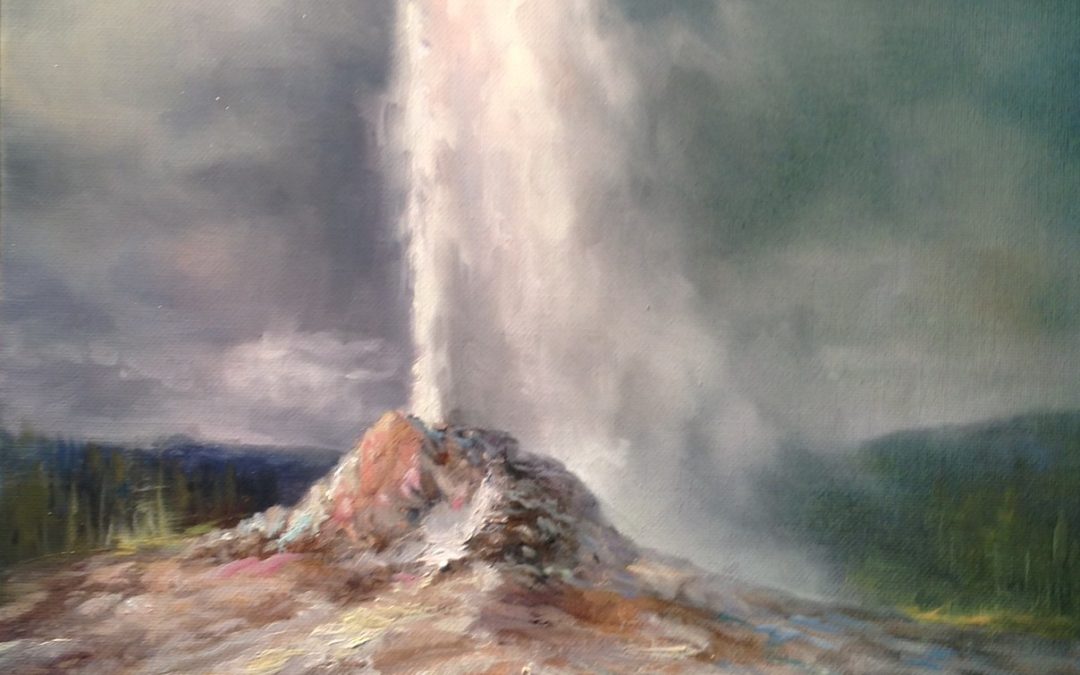“Yellowstone Geyser, Opus 1” by Stefan Baumann
Inspiration, Composition & Color Application, Part 1
When I begin a painting on location, my main objective is to capture the subject in as little time as possible, and when painting a geyser, the pressure to paint fast is even greater. Painting a geyser like one in Yellowstone Park depicted in “Yellowstone Geyser, Opus 1” is quite a challenge, as it only erupts every 12 hours and the burst of water and steam lasts only 2-3 minutes. Capturing the essence of the geyser blowing upwards into the air in such a short time requires specific prep work to make sure everything goes as planned. I filled my palette with piles of paint in various gray values and colors toned in advance, and set up my easel and supplies long before the geyser was “scheduled” to erupt. To add to the pressure, a group of “geyser watchers” were behind me betting that I could not paint the geyser in that brief of time. I’m happy to say that they lost, because I did paint the geyser while it was erupting. Ultimately, the weather really won because before I finished painting the geyser, sleet and snow began falling. I had to call it a day and retreat into my vintage Silver Streak trailer for a cup of tea while the storm blew over.
My source of inspiration for painting a geyser was the magnificent and powerful plume of steam and water that spews upwards each time the geyser erupts. I wanted to capture the effect of light on the steam as well as capturing the colorful foreground hues, and the chroma in the ground that supports the cone of the geyser as white and blue water rivulets contribute eye-catching lines that lead upwards to the geyser in this composition.
As I painted this scene, I used four of the properties of color that every artist uses when painting: hue, or the pure color of paint as seen in the foreground; temperature, found in the warm colors used in shadow or cool colors used in the highlights; chroma, adjusting the intensity of the paint from pure color to one that has been grayed down with white or a complementary color; and value, using a scale from light to dark. In this painting, I used both value and chroma to create a sense of dynamic action throughout the painting, with stark contrasts between the sky, the geyser, and the land. Using white to black values, the geyser appears to advance and the storm clouds appear to recede, and the dark values around the edges of the canvas frames the lighter, warm tones of the soil surrounding the geyser. By using tinted colors with varying intensities from bright to dull, I painted the eye magnets and featured images in the scene. To accentuate the grand finale, I created highlights on the erupting geyser to make it glow.
_________________________________________________________________________________
Plein air and Alla Prima artist Stefan Baumann, host of the PBS painting series “The Grand View, America’s National Park through the eyes of an artist” and author of “Observations Of Art and Nature,” travels in his vintage travel trailer painting America’s western landscape. Baumann paints outdoors with oils and canvas capturing stunning vistas, wildlife, western landscapes, National Parks and still life, thrilling art collectors throughout the world. He has many international collectors acquiring his paintings as investments. His painting style is called Romantic Realism with Luminism, and the extraordinary way he captures the effect of light is a truly an American style used to paint the Western landscape. He can be seen painting in Yellowstone, Yosemite and Grand Canyon National Parks. Baumann’s “how to paint” DVDs, filmed on location in the National Parks, are the very best on the art instruction market.

